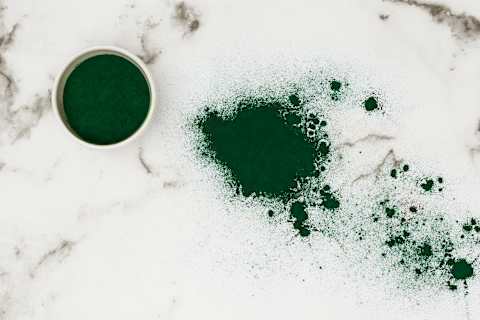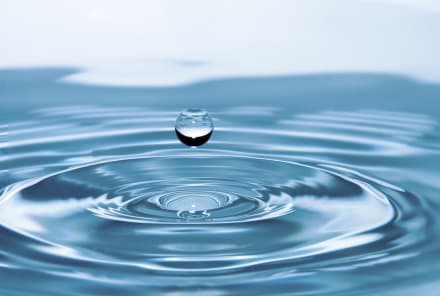Advertisement
Spirulina: The Plant-Based, Blue-Green Supplement Linked With Glowing Skin, Reduced Inflammation & Overall Health

Spirulina might sound like the kind of fun, fanciful word that a kid would mumble during a string of nonsense phrases, but it couldn't be further from the silly vibes its name might invoke. It's actually super serious as a health supplement. Spirulina is a type of bacteria called cyanobacterium, which is often referred to as blue-green algae (a name you're much more likely to have heard of), and it can benefit your body and health in an almost mind-boggling number of ways.
If the idea of putting algae into your body grosses you out, well, I would say turn away now, but you really shouldn't. Spirulina is a bona fide superfood, with a list of benefits and nutrients so long, you might want to pause for a break in the middle of reading it. This superpowered kind of algae is packed with antioxidants, vitamins, minerals, and other nutrients and has been used as a food supplement for 20 years. Here's what you need to know about spirulina, from its historical uses to its modern popularity as a supplement.
The benefits of spirulina.
Spirulina is incredibly nutrient-dense and, according to some researchers, might actually be the most nutritious food on the planet. In 1974, spirulina was actually named the "Best Food for the Future" at the United Nations World Food Conference.
"I read an article that said it's sexier to call spirulina a 'superfood' than it is to call it pond scum—because of where it grows, at the bottom of bodies of water—but that's why it's so nutritive," said naturopathic physician and registered dietitian Jaime Schehr, N.D., R.D.
So what makes spirulina so great from a nutrition standpoint? Well, first of all, it's touted as an incredible source of protein—it's between 55 and 70 percent protein and serves as a fantastic source of that basic dietary need for vegans and people without access to other forms of protein. Spirulina can be a great addition to a vegan diet considering the iron and B12 that may be naturally low in these diets.
"This diet-friendly algae contains high levels of many nutrients including calcium, potassium, B vitamins, and iron," Dr. Schehr says. "Not only does it have high amounts of many micronutrients, but it also contains amino acids, which are important components of proteins necessary for growth and repair in our bodies."
A single tablespoon of spirulina contains 4 grams of protein, as well as 11 percent of the recommended dietary allowance (RDA) of vitamin B1 (thiamin), 15 percent of the RDA of vitamin B2 (riboflavin), 4 percent of the RDA of vitamin B3 (niacin), 21 percent of the RDA of copper, and 11 percent of the RDA of iron.
In addition to all of that, spirulina also contains significant amounts of magnesium, potassium, and manganese. Magnesium1 plays a pivotal role in helping to regulate muscle and nerve function, blood sugar levels, and blood pressure in the body, as well as making protein, bone, and DNA. Potassium, which is a type of electrolyte, aids in nerve function and muscle contraction and it regulates your heartbeat. And, finally, manganese2 helps your body develop and function properly throughout your life.
Tl;dr: Spirulina is practically overflowing with nutrients that are essential to keeping our bodies functioning the way they're supposed to. You can get all of these nutrients from other sources, of course, but spirulina, as a one-stop shop for so many of them at once, is the kind of substance the word "superfood" is truly meant to describe.
Remember that break I warned you you might need to take in the middle of the list of spirulina's benefits? Now might be the time to grab a drink and settle in, because we've just cracked the surface of this superfood's potential benefits.
In addition to being ridiculously nutrient-rich, spirulina is also a powerful anti-inflammatory and antioxidant. You've probably heard the term "antioxidant" thrown around a lot, but you might not know why antioxidants are so important. Basically, they combat oxidative stress3, which has the potential to harm our cells and even our DNA. Spirulina's antioxidant properties are thanks to a substance called phycocyanin4. In addition to boasting antioxidant properties5, phycocyanin6 is also responsible for giving spirulina its vibrant blue-green color.
Oxidative stress (also known as oxidative damage) can wreak havoc on fatty structures in the body. This process, known as lipid peroxidation7, can leave affected individuals at increased risk8 for a number of serious diseases. Because spirulina is such a powerful antioxidant, it can help to prevent LDL (low-density lipoprotein—the "bad" cholesterol) lipoproteins from becoming oxidized9, which can help to ward off a number of diseases. It has specifically been tested10 on individuals with type 2 diabetes for this effect, with positive results.
On the subject of LDL, spirulina has also been shown to lower "bad" cholesterol and, in some cases, even raise "good" cholesterol (HDL, or high-density lipoprotein). In one study11, patients with high cholesterol were given one gram of spirulina daily, to amazing effects—on average, taking the spirulina lowered their triglycerides by 16.3 percent and their LDL by 10.1 percent. While 1 gram of spirulina might help lower bad cholesterol11, higher doses have been shown to bring additional benefits, like lowering blood pressure12. Researchers believe these benefits are thanks to spirulina's impact on the body's production of nitric oxide (it increases production), which helps blood vessels relax and dilate, thereby allowing blood to flow more quickly and easily.
Do you need a breath yet? Because we're still not done listing spirulina's potential health benefits.

This impressive algae also appears to have anti-cancer effects. In animals14, it's been shown to reduce cancer occurrence and the size of tumor cells. In humans, it's been proved to reduce precancerous lesions in the mouth. Notably, the lesions returned15 when the subjects stopped taking spirulina supplements. A different study16 suggested that a gram of spirulina a day might even be more effective in improving symptoms of precancerous lesions than Pentoxyfilline, a drug used in this kind of treatment.
Spirulina's benefits can also extend to allergy sufferers, for whom studies17 show 2 grams of spirulina a day can help reduce common rhinitis symptoms, like nasal congestion and sneezing. It has also been studied18 as a treatment for elderly patients19 suffering from anemia and may help increase endurance20 and muscle strength, even among younger people and athletes (although more research is needed for a conclusive answer).
One of spirulina's most impressive and wide-reaching benefits, however, is as a nutrition supplement for malnourished people, particularly children and patients with HIV and AIDS. In a pilot study21 on the use of spirulina to treat malnourished children in Central Africa, a dose of just 10 grams per day "seemed to significantly and quickly improve the nutritional status of undernourished children." Spirulina is officially recommended as a treatment for malnutrition by the World Health Organization.
Despite many studies into the effectiveness of spirulina for all sorts of uses, the U.S. National Library of Medicine maintains that there isn't enough evidence to rate its effectiveness in treating a number of conditions. The most significant danger associated with spirulina consumption, according to researchers22, is the potential for contamination, so it's important to be careful when purchasing supplements and to buy from trusted brands and sources.
What is the spirulina algae itself?
So what exactly is this wonder substance? Spirulina is a type of bacteria called cyanobacterium, which is often referred to as blue-green algae. Phycocyanin6, the substance in spirulina that makes it a powerful antioxidant, is also responsible for the algae's signature blue-green color. The color is so unique and beautiful that the FDA has actually approved it as an additive for color in gum and other foods.
Spirulina was originally classified as a plant but has since been reclassified23 as bacteria. There are a number of spirulina species, but three are the most studied23 as nutritional supplements and possible therapeutic remedies: Spirulina platensis (Arthrospira platensis), Spirulina maxima (Arthrospira maxima), and Spirulina fusiformis (Arthrospira fusiformis).
Where does spirulina come from?
Like any "super" thing, spirulina is incredibly strong and resilient; it can grow in extreme conditions that are inhospitable to many other water-dwelling organisms. Generally, however, it's grown in man-made or natural lakes. Once it's collected, it's freeze- or sun-dried.
Spirulina has been used as food for centuries in Mexico and parts of Africa. A 1997 survey recorded data about modern-day harvests in Chad24, where spirulina grows naturally and in abundant amounts and has become a staple of the locals' diets. It's harvested and then sun-dried and cut into small squares for food and for sale to local consumers. Local trade brings in about $100,000, a significant portion of the area's overall economy.
Spirulina powder and history.
When we talk about spirulina as a supplement or food source, we're typically talking about spirulina powder, which can be added to smoothies or used to fill capsules, among other things.
Spirulina has a long history and was used centuries ago by the Aztecs25. In the time of Montezuma's Empire, from 1502 to 1520, servants were required to bring the emperor fresh fish every day. The only problem was that the fresh fish were not close by. This meant servants had to jog briskly across great distances, and there's a legend that they were able to achieve this nearly-impossible feat by taking spirulina as, essentially, an energy supplement.
When the Spanish arrived in the area now known as Mexico, they reported seeing the locals eating what they described as “green foam" or "green mud"—spirulina. The algae grew naturally in the lakes that once surrounded modern Mexico City. However, as the lakes were drained, the spirulina disappeared as well, leaving the truth about the "green foam" a mystery for hundreds of years.
And back when well-known Spanish conquistador Hernán Cortés arrived in Mexico to conquer the Aztec empire, spirulina was reportedly available in markets in the area. Today, experts guess that spirulina was a staple of the diet of early Aztecs. Lake Totalcingo and Lake Texcoco are said to be two of the lakes Aztecs used to grow spirulina as a crop.

Is spirulina the "best" supplement?
There are several good arguments for spirulina being the "best" supplement available today, thanks in large part to ringing endorsements from trusted organizations like NASA, the United Nations, and the World Health Organization.
Spirulina powder owes its modern resurgence in popularity largely to NASA. The blue-green algae became famous again in the late 1980s, when NASA released a report suggesting that it could be grown in space and used by astronauts. It has been successfully used as a dietary supplement for astronauts25 on missions, which makes sense. Given the wide range of nutrients present in a single gram of spirulina powder, it's a perfect supplement for astronauts, who famously travel in cramped quarters and are looking to make everything—even their nutrition delivery systems—as compact as possible.
Another famous endorsement of spirulina as a great supplement (and, possibly the "best" supplement) comes from the United Nations, which has been studying the powerful algae as a way to combat malnutrition since 2003.
The U.N. has endorsed the use of spirulina for malnourished children and HIV/AIDS patients for a number of reasons. First, it's effective—just 1 gram of spirulina a day has been shown to correct severe malnutrition in children in just a few weeks. It also helps HIV/AIDS patients gain much-needed weight and live more comfortable lives. The second reason spirulina gets the seal of approval from the U.N.? It's crazy affordable. Feeding a starving child in India using spirulina costs just six to 12 U.S. dollars a year.
Another thing that makes spirulina such an amazing option for countries and communities battling widespread malnutrition is that it has the ability to help not only their physical health but to help them achieve economic freedom, as well. How? Basically, because spirulina is easy to grow and harvest, it could become a business venture for women in these areas.
"In the long run, there are no cheaper and better ways to sustainability than creating local businesses which make use of the knowledge and skills of local women," IIMSAM, the Intergovernmental Institution for the Use of Micro-Algae Spirulina Against Malnutrition, intergovernmental observer to the United Nations, explained in a 2010 report on spirulina. "A truly sustainable solution will emerge if rural women can be profitably involved in the eradication of malnutrition and, in the process, make a living out of it. Spirulina can become a sustainable long-term solution if programs can be designed which enable profitable enterprises that are capable of combating malnutrition as a business."
IIMSAM isn't the only group to issue glowing statements about spirulina's benefits as a source of nutrition for malnourished children, in particular.
"There is a need for both national governments and intergovernmental organizations to re-evaluate the potential of spirulina to fulfill both their own food security needs as well as a tool for their overseas development emergency response efforts," the U.N. Food and Agriculture Organization (FAO) said in a report on spirulina in 2008.
The World Health Organization has also spoken out in support of spirulina as a dietary supplement.
"For WHO, spirulina represents an interesting food for multiple reasons, rich in iron and protein, and is able to be administered to children without any risk. We at WHO consider it a very suitable food," the U.N. World Health Organization (WHO, for short), said of the super algae during a conference in Geneva, Switzerland, way back in June of 1993.
The point: Even if spirulina isn't the "best" supplement by every possible measure (which would be difficult to prove definitively, anyway), it's frequently touted as the best option for bringing nutrition to people in need, from Third World countries to outer space, which says a lot.
Which kind of spirulina supplement is most bioavailable?
Spirulina supplements can be taken as tablets or as powder. If you're dead set on taking the "best" form of the potentially best supplement, it's worth noting that powder forms of the supplement are typically more absorbable and can also be mixed into drinks.
Another thing to keep in mind when it comes to spirulina and bioavailability (the rate and extent to which a drug is absorbed and becomes available in the body) is that the bioavailability of different elements within spirulina may vary by the method of ingestion. Iron bioavailability from spirulina supplements was lower than it was in eggs but greater than in whole wheat, in one study26, for example. This means that your best method of consumption might depend on what you're hoping to get from taking spirulina. Also, no form of the supplement is regulated by the FDA, so it's best to consult your doctor about trying it and what form is best for you.
Food sources of spirulina.
Because spirulina is a form of algae, it's not naturally present in any foods (that is, you can't find it magically hidden in a banana or anything like that). However, its recent surge in popularity means that there are tons of delicious and bonkers-nutritious recipes out there to help you incorporate spirulina into your diet without just downing a tablet or a spirulina-powder-infused smoothie, like this recipe for a spirulina quinoa salad.
Overall, spirulina definitely earns its reputation as a superfood, and any way you decide to take it has the potential to help boost your health across the board.
26 Sources
- https://ods.od.nih.gov/factsheets/Magnesium-Consumer/
- https://www.ncbi.nlm.nih.gov/pmc/articles/PMC3980863/
- https://www.ncbi.nlm.nih.gov/pmc/articles/PMC5551541/
- https://www.ncbi.nlm.nih.gov/pubmed/19299804
- https://www.ncbi.nlm.nih.gov/pubmed/24691130
- https://www.ncbi.nlm.nih.gov/pubmed/12769719
- https://www.ncbi.nlm.nih.gov/pubmed/10459507
- https://www.ncbi.nlm.nih.gov/pubmed/25547488
- https://www.ncbi.nlm.nih.gov/pmc/articles/PMC4320919/
- https://www.ncbi.nlm.nih.gov/pmc/articles/PMC2788188/
- https://www.ncbi.nlm.nih.gov/pubmed/23754631
- https://www.ncbi.nlm.nih.gov/pmc/articles/PMC2211748/
- https://www.ncbi.nlm.nih.gov/pubmed/12639401
- https://www.ncbi.nlm.nih.gov/pmc/articles/PMC2695150/
- https://www.ncbi.nlm.nih.gov/pubmed/8584455
- https://www.ncbi.nlm.nih.gov/pmc/articles/PMC3919363/
- https://www.ncbi.nlm.nih.gov/pubmed/18343939
- https://www.ncbi.nlm.nih.gov/pmc/articles/PMC4012879/
- https://www.ncbi.nlm.nih.gov/pubmed/18809092/
- https://www.ncbi.nlm.nih.gov/pubmed/20010119
- https://www.ncbi.nlm.nih.gov/pmc/articles/PMC5061973/
- https://www.ncbi.nlm.nih.gov/pmc/articles/PMC3576896/
- https://www.ncbi.nlm.nih.gov/pmc/articles/PMC2907180/
- https://link.springer.com/article/10.1023%2FA%3A1008177925799
- https://www.ncbi.nlm.nih.gov/pmc/articles/PMC3136577/
- https://www.ncbi.nlm.nih.gov/pubmed/1293017
Watch Next
Enjoy some of our favorite clips from classes
Enjoy some of our favorite clips from classes
What Is Meditation?
Mindfulness/Spirituality | Light Watkins
Box Breathing
Mindfulness/Spirituality | Gwen Dittmar
What Breathwork Can Address
Mindfulness/Spirituality | Gwen Dittmar
The 8 Limbs of Yoga - What is Asana?
Yoga | Caley Alyssa
Two Standing Postures to Open Up Tight Hips
Yoga | Caley Alyssa
How Plants Can Optimize Athletic Performance
Nutrition | Rich Roll
What to Eat Before a Workout
Nutrition | Rich Roll
How Ayurveda Helps Us Navigate Modern Life
Nutrition | Sahara Rose
Messages About Love & Relationships
Love & Relationships | Esther Perel
Love Languages
Love & Relationships | Esther Perel












